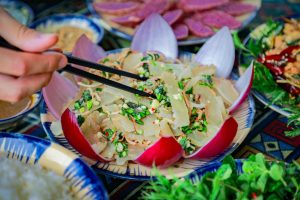Exploring the Flavors of Japan’s Culinary Scene
Japan’s culinary scene is an intricate and multifaceted fusion of centuries-old traditions, modern influences, and impeccable attention to detail. With its diverse regional specialties, unique ingredients, and meticulous preparation techniques, Japanese cuisine has garnered worldwide recognition and captured the hearts (and taste buds) of individuals from all corners of the globe. Each dish tells a story of Japan’s culture and history, making exploring the flavors of its culinary scene a truly enriching and immersive experience. So, let’s dive into the world of Japanese cuisine and discover the vibrant flavors that await us.
The Essence of Japanese Cuisine
Before delving into the specifics of Japan’s culinary scene, it’s essential to understand the core principles that underpin its cuisine. Simplicity, balance, and seasonality are the fundamental pillars of Japanese cooking. The Japanese believe that every dish should showcase the natural flavors of the ingredients, and overcomplicating a dish with too many ingredients or seasonings is frowned upon. This emphasis on simplicity allows the ingredients to shine, and each bite to be a sensory journey. Moreover, balancing different flavors and textures is a crucial element of Japanese cuisine, creating harmonious and well-rounded meals. Seasonality is also highly regarded, with Japanese chefs utilizing fresh, local produce at its peak to ensure the best flavor and quality.
Diverse Regional Specialties
Japan’s regional specialties are a testament to the country’s diverse landscapes and unique cultural influences. The northernmost island of Hokkaido is known for its rich dairy products and seafood, while the Tohoku region specializes in hearty and comforting dishes such as ramen and yakiniku. Western Japan, specifically the Kansai region, is famous for its vibrant street food culture, including okonomiyaki, takoyaki, and kushikatsu. Southern Japan offers a taste of the ocean with its abundance of fresh seafood and unique dishes like mentaiko (spicy marinated cod roe) and buri daikon (simmered yellowtail with daikon radish). Each region has its unique specialties, offering a diverse and exciting culinary landscape to explore.
The Role of Ingredients
Japanese cooking is heavily reliant on the quality and freshness of its ingredients. From seasonal produce to premium cuts of meat and fish, a dish can be elevated or ruined by the ingredients used. The Japanese have a deep respect for nature and its offerings, with ingredients like kelp, bonito flakes, and miso being considered essential in their cuisine. With a variety of cooking methods, such as grilling, stewing, and frying, Japanese cuisine transforms humble ingredients into refined and flavorful dishes.
The Versatility of Rice
Rice is an integral part of Japanese cuisine, serving as the main source of carbohydrates and a staple food in most households. Aside from its role as a side dish, rice is also used to make popular foods such as sushi, onigiri (rice balls), and mochi (sticky rice cakes). In Kyoto, a traditional meal often includes various rice dishes, showcasing the versatility of this humble grain. From a simple bowl of steamed rice to elaborate rice-based dishes, rice plays a crucial role in the flavors and textures of Japanese cuisine.
The Art of Sushi
Sushi is possibly the most iconic Japanese dish, comprising bite-sized pieces of vinegared rice topped with various ingredients, such as fresh seafood and vegetables. While sushi has become synonymous with raw fish, it actually refers to the vinegared rice used in the dish. This delicate balance of flavors, textures, and colors is what makes sushi an art form, with skilled sushi chefs dedicating years to perfecting their craft. From traditional nigiri sushi to modern creations like California rolls and fusion rolls, there’s a sushi for every palate.
Impeccable Attention to Detail
Japanese cuisine has elevated attention to detail to an art form. From the precise cutting of sashimi and the meticulous arrangement of ingredients in bento boxes to the aesthetically pleasing presentation of dishes, every aspect of Japanese cuisine is carefully thought out. This attention to detail isn’t just about making a dish visually appealing; it’s also about enhancing the overall dining experience and paying respect to the food and the people who prepare it. The Japanese take immense pride in their cooking and strive for perfection in every dish, making every meal a feast for both the eyes and the palate.
The Final Word
Exploring the flavors of Japan’s culinary scene is an immersive journey that takes you through the country’s history, culture, and exquisite cuisine. The simplicity, balance, and seasonality of Japanese cooking combined with diverse regional specialties, quality ingredients, and impeccable attention to detail make it a world-renowned culinary destination. So, the next time you sit down for a Japanese meal, take a moment to appreciate the flavors and techniques that have made Japanese cuisine the celebrated and cherished cuisine it is today.










